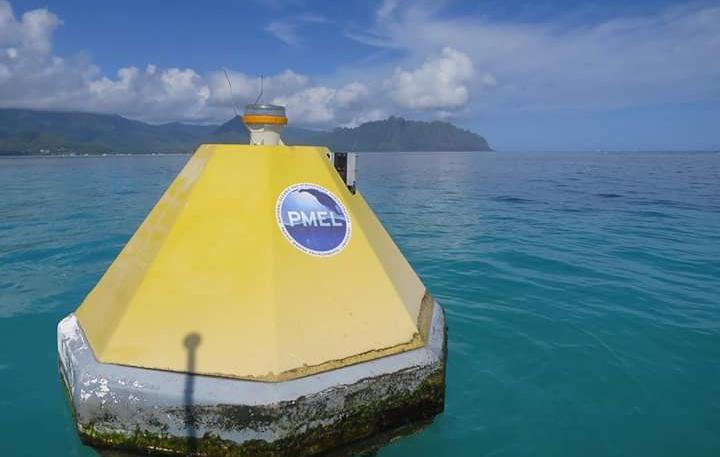Fifty years ago, NOAA created a new environmental research laboratory in Seattle with an initial focus on water quality in Puget Sound, and environmental studies of the Gulf of Alaska and Bering Sea. Since then, the Pacific Marine Environmental Laboratory has evolved into one of the world’s leading ocean research institutes, specializing in observing ocean conditions from tsunamis to changes in climate and ocean chemistry with the aid of innovative instrumentation and measurement strategies often developed by the lab.
To recognize PMEL’s half-century of accomplishments, the journal Oceanography has published a special issue with 29 diverse articles which highlight the laboratory’s scientific work over the last five decades. The issue provides new perspectives on global and regional implications of ocean acidification and its biological impacts, the influence of El Nino-Southern Oscillation on global weather patterns, and the important role marine aerosols play in regulating climate.
“PMEL researchers and their collaborators not only have fundamentally reshaped the scientific understanding of so many aspects of our ocean, their research and explorations have sparked our imagination and fascination with the deep and all that we might learn about our planet,” said NOAA Administrator and former President of The Oceanography Society Rick Spinrad, Ph.D. “Year after year, PMEL scientists continue to inspire the next generation of scientists and researchers, while providing the nation with the priceless knowledge gained by their investigations.”
Discoveries made by PMEL scientists, supported by national and international research partners, have been at the forefront of a sea of knowledge about climate change and variability, extreme weather events, the effects of climate change on marine ecosystems, fisheries oceanography, global patterns and processes of heat and carbon budgets within the oceans, Arctic oceanography, and ocean-seafloor interactive processes such like hydrothermal vents.
“We cannot understand climate change and its impacts on the world without understanding the ocean,” said PMEL director Michelle McClure. “PMEL’s scientists have been leaders in researching our marine system, and we are dedicated to providing the information we need to help society address the climate crisis in the coming decades.”
Special journal issue offers a deep dive into PMEL’s accomplishments
The Oceanography special issue covers the full range of topics that PMEL has studied over its 50 years, from the Arctic to zooplankton.
One study, led by PMEL Senior Scientist Richard Feely, provides a new assessment of rapid changes driven by ocean acidification in regions that would normally be considered refuges, threatening the protection that these regions provide for stocks of sensitive species.
A second, led by PMEL Supervisory Oceanographer Simone Alin, evaluates the sensitivity of Dungeness crab to anticipated ocean acidification trends in near-shore waters of Washington State through 2100. Their modeling studies suggest large declines in landings of crab, which for decades has been the most valuable fishery on the US West Coast, may be seen as soon as 2060 to 2070 under a high-emissions scenario.
An analysis of data collected by the Global Tropical Moored Buoy Array, led by Senior Scientist Michael McPhaden, discusses unusual developments in the El Nino-Southern Oscillation cycle over the past decade, capped off with a rare three-year or “triple dip” La Nina during 2020 – 2023. This recent period of extended cold in the tropical Pacific has upended theories of what causes multi-year La Niñas, while highlighting potential influences from the tropical Indian and Atlantic Oceans as well as from higher latitudes of the Pacific on the predictability of El Nino-Southern Oscillation events.
Decades of measurements by PMEL have revealed the important role of sulfur compounds generated by plankton, sea-spray aerosol and aerosols transported long distances in generating clouds in the marine boundary layer. As detailed in a paper led by PMEL’s lead atmospheric chemist Patricia Quinn, these measurements have been aggregated into the largest global ocean database characterizing a complex mixture of chemical components that are important for climate models to accurately model Earth’s radiation budget.
Fifty years of discovery in ocean science
Since 1974, PMEL engineers and technicians working with scientists in the lab and at sea developed a stream of new technologies needed to expand observational capabilities over vast expanses of ocean. These tools have profoundly shaped scientists’ understanding of Earth system processes, leading to advances in environmental prediction and climate assessments.
Together, this has resulted in more than 3,400 papers published by PMEL scientists over the last 50 years, work that has garnered more than 225,000 citations in peer-reviewed journals. Observational data collected by the lab are used in innumerable oceanographic studies.
“One only has to look at PMEL’s outstanding publication and citation record to know that this is a world-class organization,” said Chris Sabine, who rose from oceanographer to PMEL director during a 15-year stint with the lab. “But as anyone who has been to sea on a PMEL cruise knows, the level of professionalism and preparedness of the seagoing scientists and engineers is unsurpassed,” said Sabine, who is now an Oceanography professor at the University of Hawaiʻi at Mānoa.
“PMEL is an amazing team that includes scientists, support staff, engineers and technicians at all stages of their careers,” McClure added. “The collaboration and cooperation between them all has been a critical component of our past successes – successes that we are committed to continuing as we address the acute challenges of climate and environmental changes.”
Learn more about some of PMEL’s current research, on YouTube or on the website: https://www.pmel.noaa.gov/
Originally posted on NOAA Research on November 1, 2023 View the interactive Oceanography flipbook online: https://oceanographydigital.tos.org/flip-book/110286/579668/page/1



